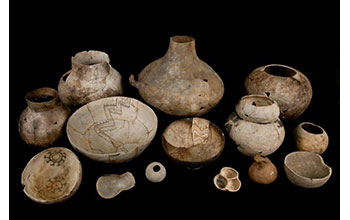Multimedia Gallery
Pottery from Southwestern U.S. around A.D. 600
Pottery became common across the Southwestern United States around A.D. 600; many vessels stored corn.
More about this image
In a study by anthropologist at Washington State University, researchers sketched out one of the greatest baby booms in North American history, a centuries-long "growth blip" among Southwestern Native Americans between 500 and 1300 A.D. It was a time when the early features of civilization -- including farming and food storage -- had matured to a level where birth rates likely exceeded the highest in the world today. But then a crash followed, which the researchers say offers a warning sign to the modern world about the dangers of overpopulation.
The study looked at a century's worth of data on thousands of human remains found at hundreds of sites across the Four Corners region of the Southwest.
"This research reconstructed the complexity of human population birth rate change and demographic variability linked with the introduction of agriculture in the Southwest U.S.," says Alan Tessier, who was acting deputy division director for the U.S. National Science Foundation's Division of Environmental Biology at the time and is now deputy division director, which supported the research through NSF's Dynamics of Coupled Natural and Human Systems Program. "It illustrates the coupling and feedbacks between human societies and their environment."
Maize -- what we know as corn -- was grown in the region as early as 2000 B.C. and by 400 B.C., the crop provided 80% of the region's calories. Crude birth rates -- the number of newborns per 1,000 people per year -- were by then on the rise, mounting steadily until about 500 A.D., with growth varying across the region.
While people in the Sonoran Desert and Tonto Basin, in what is today Arizona, were more culturally advanced, birth rates were higher among people to the north and east, in the San Juan Basin and northern San Juan regions of northwest New Mexico and Southwest Colorado.
Kohler says that the Sonoran and Tonto people eventually would have had difficulty finding new farming opportunities for many children, since corn farming required irrigation. Water from canals also may have carried harmful protozoa, bacteria and viruses. But groups to the Northeast would have been able to expand maize production into new areas as their populations grew.
Around 900 A.D., populations remained high but birth rates began to fluctuate. The mid-1100s saw one of the largest known droughts in the Southwest. The region likely hit its carrying capacity.
Then, from the mid-1000s to 1280, by which time all the farmers had left, conflicts raged across the northern Southwest but birth rates remained high. "They didn't slow down. Birth rates were expanding right up to the depopulation," says Kohler. "Why not limit growth? Maybe groups needed to be big to protect their villages and fields." But, adds Kohler, "It was a trap, however."
The northern Southwest had as many as 40,000 people in the mid-1200s, but within 30 years it was empty, leaving a mystery.
Kohler says that perhaps the population had grown too large to feed itself as the climate deteriorated. Then as people began to leave, that may have made it harder to maintain the social unity needed for defense and new infrastructure. Whatever the reason, he says, the ancient Puebloans show that population growth has clear consequences. [Research supported by NSF grant DEB 0549425.] (Date image taken: 2010-2014; date originally posted to NSF Multimedia Gallery: Aug. 16, 2017)
Credit: Bureau of Land Management/Anasazi Heritage Center Collections/Mark Montgomery
Images and other media in the National Science Foundation Multimedia Gallery are available for use in print and electronic material by NSF employees, members of the media, university staff, teachers and the general public. All media in the gallery are intended for personal, educational and nonprofit/non-commercial use only.
Images credited to the National Science Foundation, a federal agency, are in the public domain. The images were created by employees of the United States Government as part of their official duties or prepared by contractors as "works for hire" for NSF. You may freely use NSF-credited images and, at your discretion, credit NSF with a "Courtesy: National Science Foundation" notation.
Additional information about general usage can be found in Conditions.
Also Available:
Download the high-resolution JPG version of the image. (177.7 KB)
Use your mouse to right-click (Mac users may need to Ctrl-click) the link above and choose the option that will save the file or target to your computer.

 All images in this series
All images in this series